
From unsplash.com / © Nicola Gambetti
It’s Halloween today and as usual I thought I’d celebrate the occasion by displaying ten of the most interesting pieces of macabre art I’ve come across in the past year.
And what better way to start than with this illustration by the Italian-born, American-reared artist Joseph Mugnaini for Ray Bradbury’s 1972 fantasy novel The Halloween Tree? Never having read that novel, I don’t know what the winged, cadaverous, hooked-nosed figure represents, but he makes an elegant and cosmically weird image.
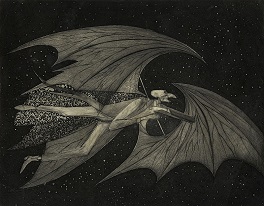
© Yearling Books / From monsterbrains.blogspot.com
In these art-themed Halloween posts I usually include something featuring skeletons, as a nod to the festival that comes immediately after Halloween – Mexico’s skeleton-obsessed Dia de Muertos, the Day of the Dead, at the start of November. This year’s skeletal number is by Vincent Van Gogh, no less. Known as Skeleton with a Lit Cigarette in its Mouth, it now resides in Amsterdam’s Van Gogh Museum. The museum’s website describes it as “a juvenile joke”, painted by Van Gogh “in early 1886, while studying at the art academy in Antwerp… Drawing skeletons was a standard exercise at the academy, but painting them was not part of the curriculum. He must have made this painting at some other time, between or after his lessons.” I find the painting discombobulating, not just because of the cigarette or, indeed, the revelation that Van Gogh, associated with intensity and misery in most people’s minds, actually had a sense of humour. No, it’s more that the skeleton is such a complex assemblage, of corners, ridges, crenels, shelves and slats. It’s almost machine-like – slightly reminiscent of the lethal, metal endoskeleton that pops up at the climax of The Terminator (1982).
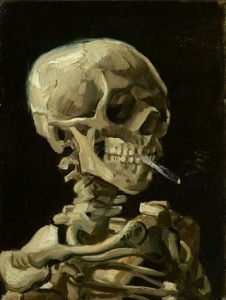
From vangoghmuseum.nl/en
Going further back in time, I have to say I love this depiction of a devil, which occupies the front side of the right-hand panel in the triptych Earthly Vanity and Divine Salvation. It was painted in the 1480s by the German-born, Bruges-based artist Hans Memling and is now on display in the Musée des Beaux-Arts in Strasbourg. It’s the merriment with which the little fellow is dancing, on top of those sinners suffering in eternal hellfire, that gets me. Why, he’s practically riverdancing.
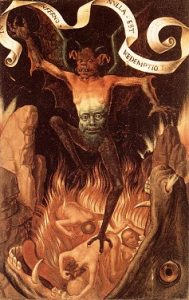
From musees.strasbourg.eu
Now for a devil from a different culture and different part of the world. This bloated, pustular apparition is what’s known as a ta-awi, a Philippine ogre / demon. I happened across it on Cryptid Wiki, which describes the beast as “a large hideous humanoid from Philippine mythology.” It “raids villages and devours people alive, but doesn’t eat their eyeballs because it can’t digest them for some reason.” All I can determine about the artist is that his name is Isaiah Paul and he has a page on deviantart.com here.
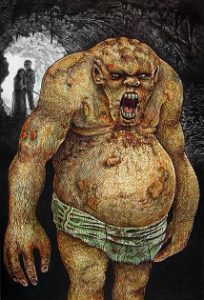
Less in-your-face and more ambiguous – the figure depicted may not even be supernatural, but just an odd person who likes to immerse herself among water lilies – is this painting, which I believe is called Hidden Things and is by modern-day Welsh artist Kim Myatt. In fact, I’d say it evokes the subtle strangeness of the fiction of Robert Aickman.
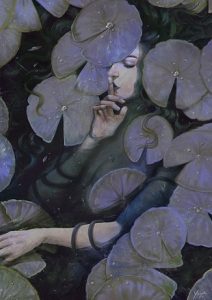
In 1980, when I was both a spotty adolescent and an aspiring writer, the first stories I ever submitted were to a handsome little magazine called Fantasy Tales. (The stories weren’t accepted, but the editors were kind enough to write back and offer me advice like “When you’re typing, try leaving a space after commas and full stops,” or “It’s probably not a good idea to have six single-sentence paragraphs in a row.”) What made Fantasy Tales so visually appealing was that it featured the artwork of Lancastrian Jim Pitts, whose exquisitely detailed and atmospheric illustrations, often in black-and-white, recalled the great artists of the 1930s and 1940s pulp-fiction magazines such as Virgil Finlay and Hannes Bok. Here’s a gothic and vampirical item that Pitts did for issue four of the magazine Dark Horizons.
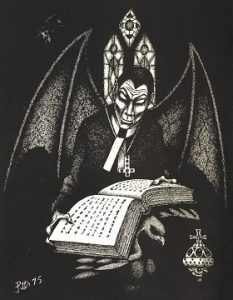
Another English illustrator I remember fondly from my youth is Les Edwards, whose work adorned the covers of paperbacks like Karl Edward Wagner’s Bloodstone (1975) and Robert Holdstock’s novelisation of the movie Legend of the Werewolf (1975). I like Edwards’ work for being unpretentious and upfront – you certainly knew what sort of book you were getting when you saw his art on the cover – but also for its precision and colour. This piece is called The Shade and achieves a chill despite its graveyard scene being pictured in daylight. There’s a suggestion of mist creeping ominously in from the distant trees and the stone angel in the foreground adds to the discomfort.
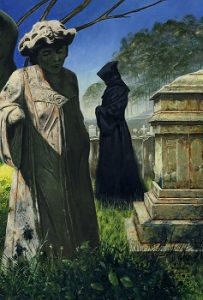
A third illustrator whose work was familiar to me in my teenage years was the American science fiction and fantasy artist Rowena Morrill, who sadly died in February this year. Morrill blazed a trail as a rare thing in 1970s paperback illustration – a woman. Her work graced the covers of the first collections of stories by H.P. Lovecraft that I managed to lay my hands on, The Dunwich Horror (1978) and The Colour Out of Space (1978). Her depictions of Lovecraft’s ‘Elder Gods’ as amalgamations of bits of wildly-different creatures may not be how most people imagine Cthulhu and company nowadays, i.e., with lots of tentacles, but they’re grotesquely and baroquely weird. Here’s the picture that adorned The Dunwich Horror.
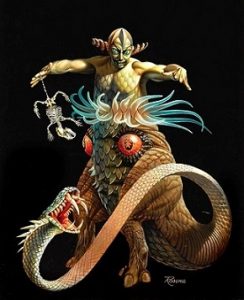
© Jove / HBJ Books
I’ve seen the Czech artist Jindra Capek described online as a ‘children’s book illustrator’. Hmm. I don’t know if the following picture, showing a hungry ghoul-type creature (though one civilised enough to be wearing what looks like a pair of boxer shorts) taking a bite out of a newly-dug-up corpse, is what you’d expect to see in the pages of a children’s book. Come to think of it, though, my ten-year-old self would have been delighted by it.
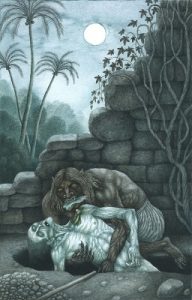
One sort of image I’ve always found unsettling is that of an insect, or general creepy-crawly, sporting the facial features of a human being. I’m thinking of David Hedison in The Fly (1958), playing a hapless scientist whose experiments with teleportation go astray and end up grafting his head onto the bug of the title; or the scuttling, insectoid, human-faced aliens in The Zanti Misfits, the famous 1963 episode of the TV anthology show The Outer Limits. Needless to say, I find this item disturbing. It’s by the Belgian artist Henri Lievens, who in his lifetime created the covers for more than 200 books. Entitled L’Araignee, its lady-faced spider is icky-looking but also, with those large doe eyes, worryingly fetching. The lurid blue and black palette heightens its effect.
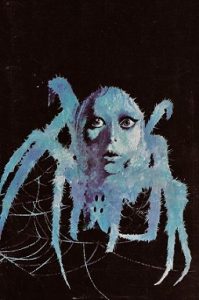
From unquietthings.com
And that’s it for another year. Happy Halloween!


